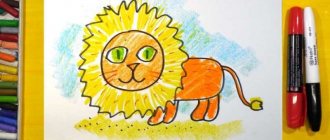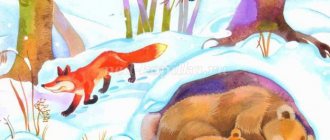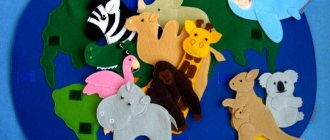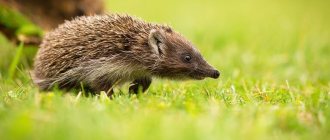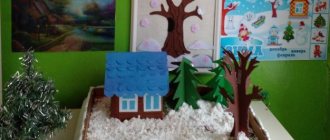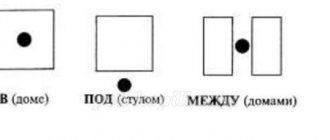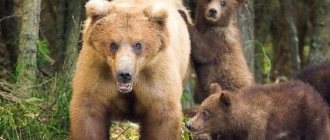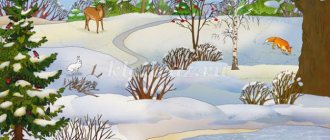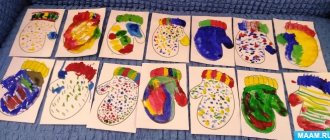Preview:
Group: senior group
Project theme: wild animals in autumn
The goal of the project: to expand children’s understanding of the wild animals of our forests, their appearance, body structure, habits, the color of the fur of some animals in winter, adaptation to their habitat and seasonal changes. To develop and encourage cognitive activity and respect for living nature in children. Cultivate a love for animals.
Organization of a developmental environment for children’s independent activities:
Pencils, paints, pencils, eraser, etc.
CENTER FOR WORK WITH THE BOOK Reading R. Kipling “Mowgli”, V. Suteev “Fisherman Cat” L. Tolstoy “The Lion and the Dog” D. Mamin-Sibiryak “The Tale of the Brave Hare Long Ears - Squinty Eyes”, M. Prishvin “Hedgehog” ", "Fox Bread" P. Ershov "The Little Humpbacked Horse", I. Krylov "Crow and the Fox", "Quartet", Br. Grimm "Hare and Hedgehog", "Musicians of Bremen", E. Charushin "Bear Cub" (record .101), A. Milne “Winnie the Pooh and everything, everything”; “How the badger and the marten had a lawsuit
Role-playing games: “Zoo”, “Circus”, “Veterinary hospital”, “Farm”
Outdoor games: “Sly Fox”, “Wolf in the Moat”, “Hunters and Monkeys”
Low mobility: “Earth, air, water” (with ball)
Didactic games: “guess who”, “Who lives where”, “Whose house”, “Whose trace”, “Winter supplies”, Name the predators”, “Name the herbivores”, “Who eats what”, “How it moves”, “ How it screams”, “Whose cub”, “Name the family”, “One-many”, “The fourth wheel”, “Who is afraid of whom”, “Who defends himself”, “Find commonalities and differences”
Theatrical games: imitation of animal habits and movements, onomatopoeia.
Hares jump hop-hop-hop,
Yes to the white snow
They crouch down and listen to see if a wolf is coming!
Once - bend over, straighten up,
Two - bend down, stretch,
Interaction with parents/social partners: completing homework according to the notebook of the speech therapist teacher. Ask parents to bring encyclopedias about wild animals for their children to study.
Walk 1 Observation of a living object - observation of wintering birds: sparrows, pigeons, crows. What are these birds called? Where do they live? What do they eat? How should they be helped? What kind of birds are these (wintering ones? pour food into the feeder and watch the birds. D / and “Good - bad” teach you to see contradictions in nature, the ambiguity of phenomena, the relationship between living and nonliving things; develop speech and thinking Game-fun “Animal Choir”
Goals: to develop pitch and timbre hearing, creative activity, to consolidate knowledge of animal voices. KGN. Fostering a culture of eating. Reading Russian folk tales “The Little Fox and the Gray Wolf”
Evening Health-improving gymnastics after sleep. Work in a children's laboratory. “Experiments with a magnet” consolidate children’s knowledge about the properties of a magnet to attract metal objects. Continue to work on self-care for children, teach how to keep their clothes in order. Board and printed game “Zoological Lotto” D/ and “Confusion” Learn to reason and draw the right conclusions.
Reading “Autumn” by A. Maykov teaches to listen to a literary work and see the beauty of nature.
Walk 2 Observations of trees and bushes. Name what 2-3 species of trees and shrubs you know. Why do I sometimes cover trees and shrubs with snow? How do trees protect themselves from the cold in winter? How do people protect them from the cold?
9.00-9.20 FEMP/PICD (1.3 week/2.4 week)
15.20- 15.40 Speech development/CHL (1.3 week/2.4 week)
Develop artistic perception and aesthetic taste, develop literary speech. Retelling of E. Charushin’s story “Little Foxes” (Ushakova, 47)
Goal: coherent speech: development. the ability to expressively retell a literary text without the help of questions from the teacher; vocabulary and grammar: invent riddles; select adjectives and verbs according to their meaning; agree adjectives with nouns. in gender and number; sound culture of speech: be able to use exclamatory intonation.
Morning: D/ and “What’s missing?” development of attention and memory. Comparison of fox and dog. Learn to compare animals according to several characteristics, finding similarities and differences. morning Gymnastics. Ind work Compiling a story based on the picture “In the forest”
Evening Gymnastics after sleep, walking along massage paths. Read Sokolov-Mikitov “The Bear Family” to expand knowledge about bears and answer questions about the content. S/r game “Zoo” to consolidate and enrich knowledge about animals. Didactic game “Say the opposite”
— The hare has a short tail and ears. long.
- The hedgehog is small, but a bear. big.
- The hare is fluffy, and the hedgehog. barbed.
- The hare is gray in summer, and in winter. white.
- A fox has a long tail, like a bear. short. Etc.
Walk 2 Observing snow - continue to introduce the properties of snow. Research activities. Catch a snowflake in your palm and examine it. Compare two snowflakes. Determine the place where the snow melts faster. Find a place where the snow has not yet melted. Reinforce the concept of “wild” animals. Children's games with external materials
Morning: Conversation “What I saw on the way to the kindergarten” to develop monologue speech and the ability to describe the surrounding reality. The game “Name the Cub” teaches you to correctly name the cubs of wild animals and expand your vocabulary. D/i “Whoever finds it, let him take it” to develop the ability to navigate in a room. morning Gymnastics. Ind. Work: compiling a story about animals based on a picture. Enrich the vocabulary of signs and actions by designating qualities (features of appearance, nutrition, habits). D/i “Name the family” teach to identify essential features when generalizing - animals, find animals of the same species.
Walk 1 Observations of plants. The trees stand without leaves, but there are buds. Explain. That the trees no longer grow, they are at rest. Conversation “How they looked for traces of autumn” Find traces of autumn, and sketch them in a group. P/i "Sly Fox"
KGN. Continue to teach children to wash their hands thoroughly with soap before eating. Reading the fairy tale “The Fox and the Jug”
Walk 1 Watching the sun It shines less often and rises low.
Conversation “Why it became cold” goal: to consolidate ideas about seasonal changes in nature. D/i “Edible – inedible” to consolidate knowledge about vegetables
Work. Sweeping paths. S/r and “Zoo” teach how to independently develop the plot of the game, develop creativity and imagination.
Ts.: consolidate the ability to take on various roles in accordance with the plot of the game.
15.20 – 15.40 Modeling/Applique (1.3 weeks/2.4 weeks)
“Bear” (Steinle p.66)
Objectives: continue to introduce the techniques of sculpting objects with spherical and oval shapes, connecting parts by squeezing, strengthen the skill of pulling, and cultivate a caring attitude towards animals.
Summary of the drawing lesson “Who lives in the autumn forest!”
Program content: develop children's intentions - continue the content of the previous lesson, teach children to pretend to be a bunny, strengthen the ability to hold a brush, use a napkin. Use appropriate colors to depict animals.
Vocabulary: verbs: typing, drawing, jumping, sitting, huddled, scared.
Adjectives: joyful, bright, fluffy, gray, red, yellow, orange, sad, cowardly;
Nouns: hare, trees, leaves, fur coat, paws, hare's head;
Adverbs: above, below, left, right.
Equipment: drawings from the previous lesson, paints, brushes, napkins.
Preliminary work: looking at illustrations, albums, for coloring.
Methodological techniques: questions that activate children’s speech, conjugate and reflective speech, game techniques.
Guys, in the last lesson you painted a joyful autumn. Today let's introduce animals into our forests. Who can you meet in the autumn forest? (bunny, hedgehog). Yes, all these animals can be found in the autumn forest, but we will place a bunny. Look, different bunnies came to visit us. Let's look at them. What does the bunny have? (torso, paws, head, tail, ears, eyes...)
Which body part is larger? (torso)
The head is located slightly to the side at the top of the body.
What ponytail? (the hare's tail is small, located on the other side of the body).
Where are the bunny's paws? (below, under the body)
What color is the fur coat? (gray, brown)
Look, guys, how you can depict a bunny (laying it out on a flannelgraph in parts). If we draw a bunny's paws like this, what will he do? (bunny sits, snuggles, jumps, runs)
What geometric shapes will we use to draw a bunny? (from ovals) What color? (gray)
Look, I'll show you how to draw a bunny. I wet the brush in water, pick up brown paint over the entire pile, remove the excess paint on the edge of the jar, and take the brush by the iron shirt. I start drawing from the torso.
What shape is the body? (oval). I put the brush to the paper with all its bristles, the brush runs in a straight line, curves, runs along the short side, curves, runs along the long side, curves and runs back to where it was. Now let’s paint over the body with straight lines, without going beyond the edges (show).
Then I draw the head, a slightly smaller oval, paint it over, draw long ears on the bunny, and a small fluffy tail. Now I’ll draw the paws - the bunny is lurking. All that remains is to draw the eyes, nose, and antennae, but you need to wait until the paint dries. So I got a bunny.
Here I drew a big bunny, and in the forest we have to draw a small one. A bunny can be drawn under a Christmas tree, a tree, or just running along a path. Look (showing the work of a teacher).
Before we get to work, let's remember where we start?
Let's choose which bunny we will draw, first we will draw the body, oval in shape, then the head, ears, tail, paws, eyes, nose, antennae.
Now let's get our fingers ready for work.
Finger gymnastics. The bunny's ears are long
They stick out from the bushes.
He jumps and jumps,
Makes your bunnies happy.
Part 2.
Children's work. Individual conversations with children: What are you doing?
I pick up the paint, press the whole pile into place and paint the body. What kind of bunny do you have? (small, fluffy, he runs along the path)
Where are a bunny's ears? (he flattens his ears)
Part 3.
Analysis: children's works are exhibited (a bunny arrives).
Thanks guys. Now I will have a lot of fun in the forest, look how different the bunnies are: cowardly, running, jumping.
My bunny is sitting under the Christmas tree, waiting for his mother to come for him. He is fluffy, gray, he has a head, a tail, a body, and paws.
Analysis drawing “Who lives in the autumn forest.”
Program content: learn to develop the idea of the previous lesson, learn to depict a bunny, consolidate the ability to hold a brush, use a napkin, use appropriate colors (learn to mix white and black paints)
Verbal: typing, drawing, mixing, jumping, sitting, snuggled, scared.
Adjectives: joyful, bright, fluffy, gray, red, yellow, orange, sad, cowardly.
Nouns: hare, tree, leaves, coat, paws, head, tail.
Adverbs: above, below, left, right.
Methodological techniques: explanation, reminder, full and partial display, analysis of children's work, questions for children, activating vocabulary, introducing a model-description, surprise moment, game techniques.
Equipment: brush, napkin, paints, children’s work from the previous lesson.
Preliminary work: looking at illustrations.
Analysis: The children's active and passive vocabulary developed. The assigned tasks were achieved: coherent speech developed, the composition of a monologue-description was developed, and along with speech tasks, tasks on art activities were solved, and the concept of the previous lesson continued to be developed. They taught how to draw a hare from ovals of different sizes, reinforced the ability to hold a brush correctly, and taught how to mix paints.
All necessary equipment was prepared for the lesson. We used the help of the children on duty. Before the lesson, preliminary work was done: looking at the illustrations (the bunny is sitting, running), answering the teacher’s questions about the picture. During the lesson we used different methods and techniques of work: full and partial demonstration, explanation, reminder, analysis of children's work, questions for children, use of a model, game techniques, a surprise moment when organizing a lesson.
Throughout the lesson, the children's vocabulary developed: verbal - typing, drawing, jumping, running, sitting, scared, mixing; dictionary of adjectives: joyful, bright, fluffy, gray, red, yellow, orange, cowardly; dictionary of nouns: hare, trees, leaves, fur coat, paws, head, tail; dictionary of adverbs: above, below, left, right; dictionary of numerals.
The children's vocabulary was activated in Part I of the lesson when answering the teacher's questions, in Part II - during individual dialogues with children (for example: what kind of bunny do you have? I have a cowardly bunny, he hid under the tree from the wolf), and also in Part III when analyzing works Children agree adjectives with nouns (cowardly bunny); numerals with nouns (one bunny under the tree).
When analyzing children's works, children make up short stories about their drawing. Children talk about their bunnies using a model, their color, size, position of the hare and the accuracy of their work.
Step-by-step schemes for kids
There are many simple patterns that make beautiful drawings; for children, animals are of more interest than household items or landscapes, so you should start with them.
A simple example of drawing a bird. Children love to feed the ducks on the ponds, any child would love to draw their own duck.
- The creative process begins with two ovals: the head and the torso, connected to each other by a short neck.
- Paws are drawn from the body down.
- On the duck's body, just below the middle, draw an arc representing a folded wing.
- Sharpen the edge of the oval from the tail side using an eraser. The tail is depicted by several almost parallel lines of short length
- A beak and an eye are drawn to the duck's head.
- The final touch is adding details in the form of drawing feathers throughout the body and wing of the bird.
- Now you can color it.
How to draw a duck
